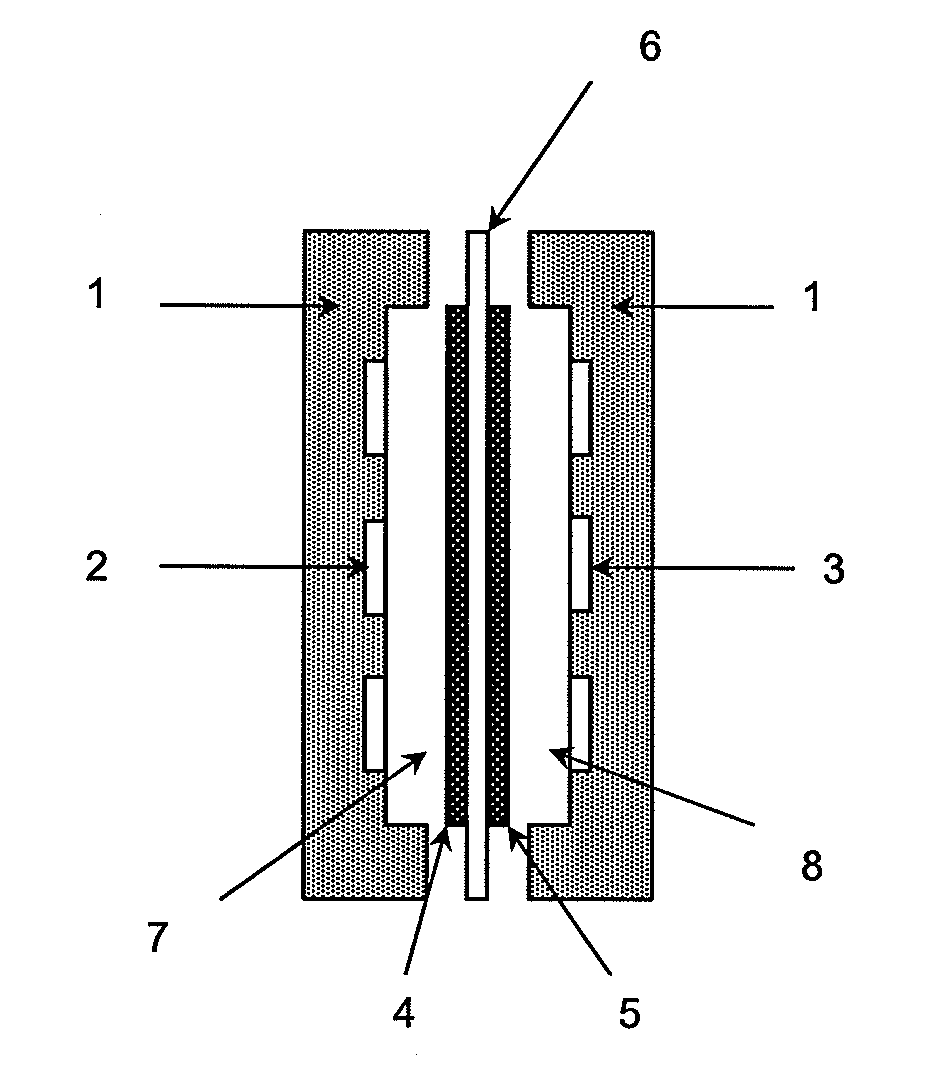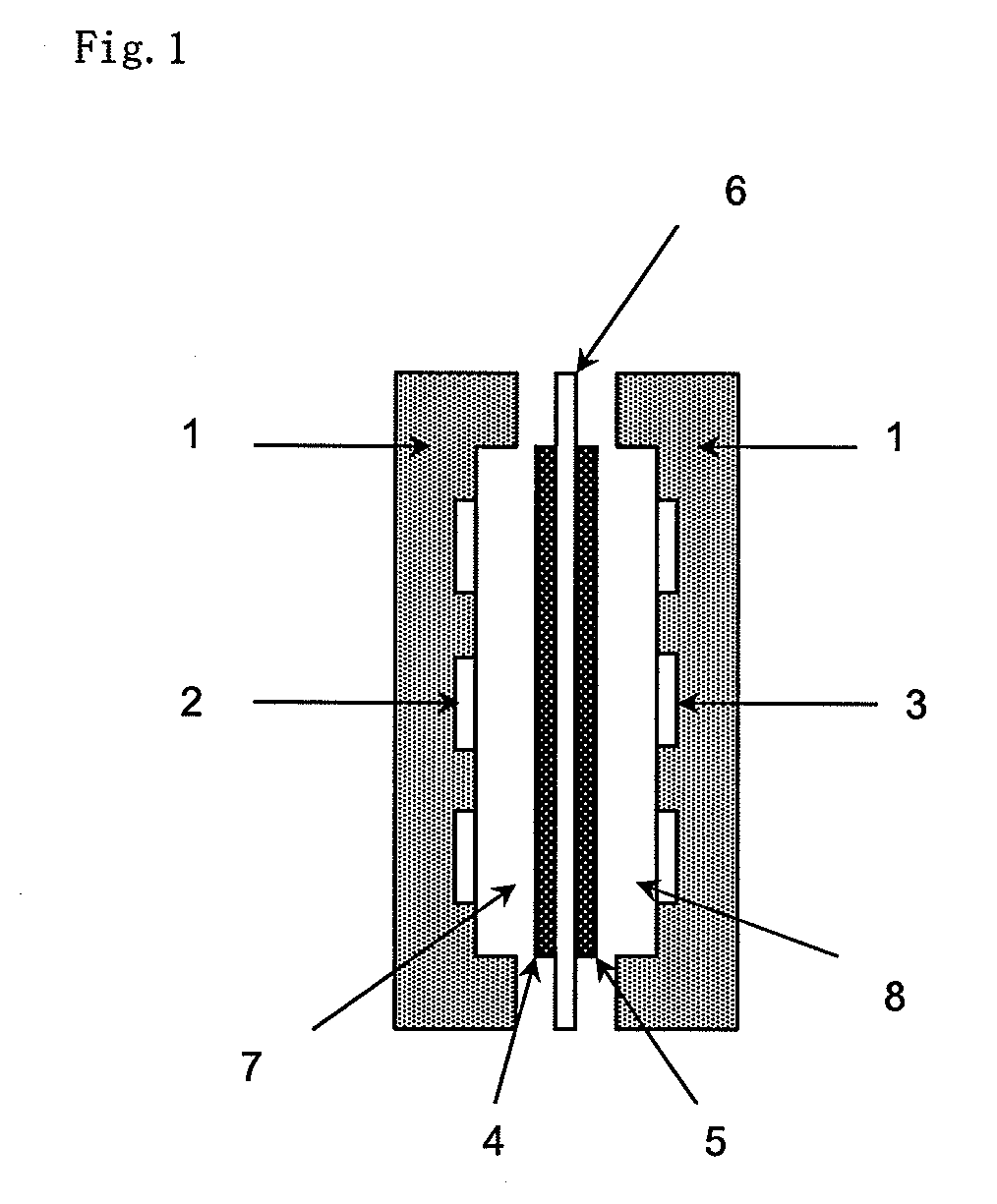Method for Producing an Anion-Exchange Membrane for a Solid Polymer Electrolyte Type Fuel Cell
a solid polymer electrolyte and fuel cell technology, applied in the direction of final product manufacture, sustainable manufacturing/processing, electrochemical generators, etc., can solve the problems of repeated impregnation, cost reduction limitations, and high cost of perfluorocarbon sulfonic acid resin membranes, so as to improve safety and certainty in operation, the effect of small load on the anion exchange membran
- Summary
- Abstract
- Description
- Claims
- Application Information
AI Technical Summary
Benefits of technology
Problems solved by technology
Method used
Image
Examples
examples
[0082]Hereinafter, the present invention will be explained further in detail based on examples, but the present invention is not limited to the examples. Note that the properties of the anion-exchange membrane shown in the examples and comparative examples were measured by the following methods.
[0083]1) Ion-Exchange Capacity of Anion-Exchange Membrane
[0084]Each counterion type anion-exchange membrane was immersed in 0.5 mol / L-NaCl aqueous solution for 10 hours or more to convert the same to the chloride ion type, followed by drying under reduced pressure at 60° C. for 5 hours and cutting so as to have dry weight of 0.1 g. The anion-exchange membrane was converted to the nitrate ion type with 0.2 mol / L-NaNO3 aqueous solution, and the quantity of the resulting free chloride ion was determined with a potentiometric titrator (COMTITE-900 of Hiranuma Sangyo Co., Ltd.) by using silver nitrate aqueous solution (mmol). The ion-exchange capacity was calculated by the following formula.
(Ion-E...
manufacturing examples 1 to 4
Production of Anion-Exchange Membrane by Method a) and Method b)
[0114](Preparation of Raw Membranes for Anion-Exchange Membranes 1 to 3)
[0115]According to composition table shown as Table 1, a variety of monomers were mixed to obtain respective monomer compounds. 400 g of the obtained monomer compound was placed in 500 ml-glass container, into which the porous membrane (polyethylene-based, having weight average molecular weight of 250,000, membrane thickness of 25 μm, average pore diameter of 0.03 μm and porosity of 37%) was immersed.
[0116]Then, the porous membrane was taken out of the monomer compound, and 100 μm-polyester film was used as a remover to coat the both surfaces of the porous membrane, followed by polymerization under nitrogen pressure of 0.3 MPa at 80° C. for 5 hours. As a result, raw membranes for forming anion-exchange membranes 1 to 3 were respectively produced.
[0117](Preparation of Anion-Exchange Membranes 1 to 4 including a Quaternary Ammonium Group or Quaternary...
production example 5
Production of Anion-Exchange Membrane by Method c)
[0119]10 mass % of chloromethyl styrene and 20 mass % of triethyl amine. were reacted in acetone solvent at 40° C. for 40 hours to obtain N,N,N-triethyl(vinylphenyl)methyl ammonium chloride. This was cooled to −5° C., recrystallized and isolated, followed by dissolving the same in toluene at a concentration of 10 mass %, and 0.005 mass % of 2,2-azobis(2-methyl butyronitrile) was further dissolved therein. After nitrogen bubbling, this solution was subjected to polymerization at 50° C. for 72 hours. The solution after polymerization was reprecipitated by pouring the same in excessive amounts of methanol followed by drying to obtain a solid matter. This solid matter was dissolved in tetrahydrofuran at a concentration of 40 mass %, and the solvent was dried after impregnation of porous membrane (polyethylene-based, having weight average molecular weight of 250,000, membrane thickness of 25 μm, average pore diameter of 0.03 μm and porosi...
PUM
| Property | Measurement | Unit |
|---|---|---|
| Percent by mass | aaaaa | aaaaa |
| Percent by mass | aaaaa | aaaaa |
| Percent by mass | aaaaa | aaaaa |
Abstract
Description
Claims
Application Information
 Login to View More
Login to View More - R&D
- Intellectual Property
- Life Sciences
- Materials
- Tech Scout
- Unparalleled Data Quality
- Higher Quality Content
- 60% Fewer Hallucinations
Browse by: Latest US Patents, China's latest patents, Technical Efficacy Thesaurus, Application Domain, Technology Topic, Popular Technical Reports.
© 2025 PatSnap. All rights reserved.Legal|Privacy policy|Modern Slavery Act Transparency Statement|Sitemap|About US| Contact US: help@patsnap.com


